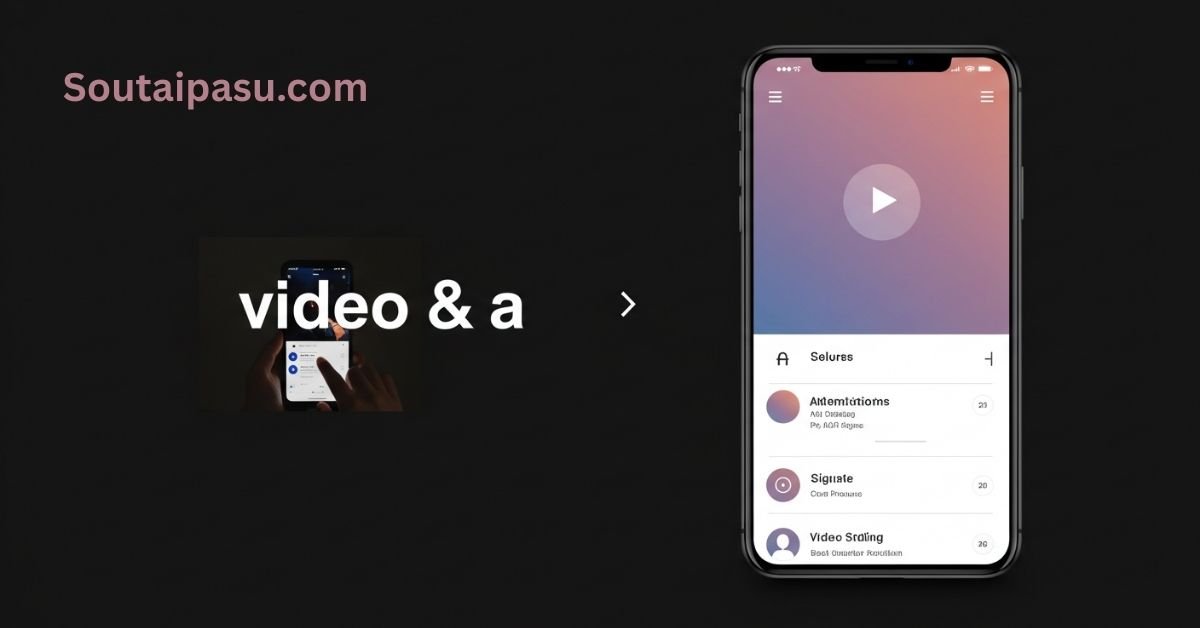In today’s digital-first world, video and audio content shape how people learn, communicate, and entertain themselves. Whether it’s a YouTube tutorial, a podcast, or a cinematic experience, the combination of video and audio—often referred to as Video&A—is the most powerful way to capture attention and deliver messages.
This article explores what Video&A means, its applications across industries, the technology behind it, and how it continues to transform the way we consume media.
Contents
- 1 What Does Video&A Mean?
- 2 The Evolution of Video&A
- 3 Why Video&A Matters?
- 4 Applications of Video&A Across Industries
- 5 Types of Video&A Content
- 6 Technology Behind Video&A
- 7 The Role of Video&A in Communication
- 8 The Future of Video&A
- 9 Tips for Creating Effective Video&A Content
- 10 Challenges in Video&A
- 11 Conclusion
- 12 Frequently Asked Questions (FAQ)
What Does Video&A Mean?
The term Video&A simply represents the integration of video (visuals) and audio (sound). Both are necessary for contemporary digital communication.
- Video delivers visuals such as images, motion, animations, and live recordings.
- Audio provides voice, music, and sound effects that make the content more engaging.
When combined, video and audio create an immersive experience that neither could achieve alone. For example, a movie without background music feels incomplete, and an audio podcast without visuals may fail to hold attention for long.
The Evolution of Video&A
The use of video and audio together has evolved over decades:
Early Beginnings
- Silent films in the early 20th century relied heavily on visuals before synchronized sound was introduced.
- In 1927, The Jazz Singer marked the beginning of films with synchronized audio, changing cinema forever.
The Television Era
- By the mid-20th century, television brought moving images and sound into homes, creating a shared cultural experience.
The Digital Revolution
- The rise of VHS, DVDs, and later streaming services transformed how video and audio were distributed.
- Platforms like YouTube, Netflix, and Spotify merged video and audio for on-demand global access.
The Current Era
- Today, Video&A is everywhere: from social media reels to business meetings on Zoom.
- It’s not just entertainment—it’s education, marketing, training, and personal connection.
Why Video&A Matters?
The reason video and audio are powerful together lies in human psychology. Audio provides emotional weight and clarity, and people assimilate visual information more quickly than words.
Benefits of Video&A Content
- High Engagement – Videos with clear audio hold viewers’ attention longer than text or still images.
- Better Retention – Studies show people remember more when learning from both visuals and sound.
- Emotional Impact – Music, tone of voice, and sound effects can move audiences in ways visuals alone cannot.
- Accessibility – Subtitles, voiceovers, and captions make content more inclusive.
- Versatility – Works across industries: education, business, entertainment, healthcare, and more.
Applications of Video&A Across Industries
1. Entertainment and Media
- Movies & TV Shows: Depend on synchronized audio and video for storytelling.
- Streaming Platforms: Services like Netflix and Disney+ offer on-demand video with high-quality audio.
- Music Videos: Combine audio tracks with visuals to promote songs.
2. Education and E-Learning
- Online Courses: Platforms like Coursera and Udemy rely on video lectures with audio explanations.
- Virtual Classrooms: Teachers use video calls with audio interaction to engage students.
- Explainer Videos: Simplify complex concepts through animation and narration.
3. Business and Corporate Training
- Webinars: Companies use video conferences with audio discussions to reach global audiences.
- Employee Training: Instructional videos improve skill-building.
- Product Demos: Videos with voiceovers explain product features clearly.
4. Healthcare
- Telemedicine: Doctors consult patients via video calls.
- Health Awareness Videos: Spread vital health information effectively.
5. Marketing and Advertising
- Commercials: Depend heavily on catchy visuals and jingles.
- Social Media Marketing: Short-form video with sound trends drives engagement on TikTok, Instagram, and YouTube.
- Brand Storytelling: Companies build emotional connections using video narratives supported by music and dialogue.
Types of Video&A Content
Different formats of Video&A suit different purposes.
| Type of Content | Purpose | Example Platforms |
|---|---|---|
| Short-form Videos | Entertainment, quick info | TikTok, Instagram Reels |
| Long-form Videos | Education, documentaries | YouTube, Netflix |
| Podcasts with Video | Discussions, interviews | Spotify, YouTube Podcasts |
| Livestreams | Real-time engagement | Twitch, Facebook Live |
| Animation & Motion Graphics | Simplified explanations | Business training, explainer videos |
Technology Behind Video&A
The seamless integration of video and audio is possible due to advances in technology.
Recording Tools
- Cameras & Smartphones: Capture visuals with audio.
- Microphones: Ensure clear sound quality.
Editing Software
- Video Editors: DaVinci Resolve, Adobe Premiere Pro, and Final Cut Pro.
- Audio Editors: Audacity, Logic Pro, FL Studio.
Streaming and Sharing Platforms
- YouTube, Vimeo, and Dailymotion for public video sharing.
- Zoom, Microsoft Teams, and Google Meet for business communication.
File Formats
- Video: MP4, MOV, AVI.
- Audio: MP3, WAV, AAC.
- Integrated: Video files with embedded audio streams.
The Role of Video&A in Communication
In the modern age, video and audio are at the heart of communication.
- Personal Connections: Families use video calls to stay in touch across continents.
- Professional Networking: Businesses rely on virtual meetings and presentations.
- Social Interaction: Platforms like Instagram, TikTok, and YouTube enable people to express themselves visually and vocally.
The Future of Video&A
The importance of video and audio will only grow with emerging technologies.
Trends to Watch
- Virtual Reality (VR) and Augmented Reality (AR)
- Immersive video and spatial audio for gaming, training, and virtual tourism.
- Artificially Enhanced Content
- Tools that improve audio clarity and video resolution automatically.
- Interactive Videos
- Viewers will choose storylines or outcomes in real-time.
- Live Shopping
- Combining video streams with audio sales pitches for e-commerce.
- Sustainability and Accessibility
- More captions, translations, and adaptive audio/video features for diverse audiences.
Tips for Creating Effective Video&A Content
If you want to create impactful content that blends video and audio, keep these points in mind:
1. Prioritize Clear Audio
Even the most visually stunning video fails if the audio is unclear. Invest in a good microphone.
2. Keep It Concise
Attention spans are short, so deliver messages quickly and clearly.
3. Use Music Wisely
Instead than overpowering the images, background music should enhance them.
4. Add Subtitles or Captions
This makes your content more accessible and viewer-friendly.
5. Maintain High Visual Quality
Clear, well-lit visuals enhance professionalism and audience trust.
Challenges in Video&A
Despite its many advantages, producing and consuming Video&A content comes with challenges:
- High Production Costs: Professional-quality video and audio require investment.
- Bandwidth and Storage: Large files may be difficult to stream or download.
- Content Overload: With so much video online, standing out is harder than ever.
- Accessibility Issues: Poor captioning or audio mixing can exclude some audiences.
Conclusion
Video and audio—together forming Video&A—are the backbone of modern communication. From entertainment and education to marketing and healthcare, their combined power shapes how we learn, connect, and experience the world.
As technology continues to evolve, Video&A will become more immersive, interactive, and accessible, ensuring it remains at the heart of digital life. For creators, businesses, and everyday users, understanding the value of video and audio integration is essential in making content that truly resonates.
Frequently Asked Questions (FAQ)
Q1: What does Video&A mean?
Video&A refers to the integration of video (visuals) and audio (sound) to create engaging multimedia content.
Q2: Why is Video&A important?
Because combining visuals and sound increases engagement, improves retention, and makes communication more effective.
Q3: Where is Video&A used most often?
It is widely used in entertainment, education, business training, marketing, healthcare, and personal communication.
Q4: What tools are needed to create Video&A content?
You need a camera or smartphone, a good microphone, and editing software such as Adobe Premiere Pro or Audacity.
Q5: What formats are common for Video&A?
The most common video formats are MP4 and MOV, while MP3 and WAV are popular for audio. Together, they are often embedded into MP4 files for sharing.
Q6: What is the future of Video&A?
Future trends include VR/AR experiences, interactive video, AI-powered audio/video enhancements, and more accessible content for global audiences.



